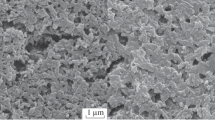Abstract
The formation mechanism of nanostructured polyaniline (PANI) synthesized in a micelle-like system was studied by a series of in situ NMR experiments, including 1H NMR and CPMG. Depending on the signal evolution of the major species, the polymerization of polyaniline was divided into three continuous stages. At first, the neutral aniline molecules changed into anilinium, and the aniline dimer produced; and then, the consumption of aniline increased rapidly, the phenazine-like oligomers occurred and hydrated water increased, the micelles remained spherical; the different morphologies of polyaniline were formed by the fusion of spherical micelles in final. In combination with the evolution of the morphology which was characterized through TEM, the formation mechanism of nanostructured polyaniline was compared and analyzed.






Similar content being viewed by others
References
S. Xiong, Y. Zhang, Y. Wang, B. Wu, J. Chu, X. Wang, R. Zhang, M. Gong, Z. Li, Z. Chen, Comparative study on the supercapacitive properties of PANI nanofibers, nanotubes, and nanospheres[J]. High Perform. Polym. 32, 600–608 (2020)
H. Kumar, A. Boora, A. Yadav, R. Rajni, Polyaniline-metal oxide-nano-composite as a nano-electronics, opto-electronics, heat resistance and anticorrosive material. Results Chem. 2, 1000463 (2020)
P. Singh, S.K. Shukla, Advances in polyaniline-based nanocomposites[J]. J. Mater. Ence 55(14), 1–35 (2020)
Y.F. Huang, C.W. Lin, Exploration of the formation mechanisms of polyaniline nanotubes and nanofibers through a template-free method[J]. Synth. Met. 159(17–18), 1824–1830 (2009)
J. Stejskal, I. Sapurina, M. Trchova, Polyaniline nanostructures and the role of aniline oligomers in their formation[J]. Chem. Inf. 35(12), 1420–1481 (2010)
X. Zhang, H.S. Kolla, X. Wang, K. Raja, S.K. Manohar, Fibrillar growth in polyaniline[J]. Adv. Func. Mater. 16(9), 1145–1152 (2010)
Z.D. Zujovic, C. Laslau, G.A. Bowmaker, P.A. Kilmartin, A.L. Webber, S.P. Brown et al., Role of aniline oligomeric nanosheets in the formation of polyaniline nanotubes[J]. Macromolecules 43(2), 662–670 (2010)
H.D. Tran, J.M. D’Arcy, Y. Wang, P.J. Beltramo, V.A. Strong, R.B. Kaner, The oxidation of aniline to produce “polyaniline”: a process yielding many different nanoscale structures[J]. J. Mater. Chem. 21(11), 3534–3550 (2011)
C. Laslau, Z. Zujovic, J. Travas-Sejdic, Theories of polyaniline nanostructure self-assembly: towards an expanded, comprehensive Multi-Layer Theory (MLT)[J]. Prog. Polym. Sci. 35(12), 1403–1419 (2010)
J. Li, L. Zhu, W. Luo, Y. Liu, H. Tang, Correlation between one-directional helical growth of polyaniline and its optical activity[J]. J. Phys. Chem. C 111(23), 950–957 (2007)
J. Stejskal, I. Sapurina, M. Trchová, E.N. Konyushenko, Oxidation of aniline: polyaniline granules, nanotubes, and oligoaniline microspheres[J]. Macromolecules 41(10), 3530–3536 (2012)
L. Zhang, M. Wan, Self-assembly of polyaniline: from nanotubes to hollow microspheres[J]. Adv. Func. Mater. 13(10), 815–820 (2003)
Z. Wei, Z. Zhang, M. Wan, Formation mechanism of self-assembled polyaniline micro/nanotubes[J]. Langmuir 18(3), 917–921 (2002)
M.A. Shahbazi, E. Mäkilä, N. Shrestha, J. Salonen, J. Hirvonen, H.A. Santos, Controlled shape and nucleation switching of interfacially polymerizable nanoassemblies by methyl substitution[J]. Chem. Mater. 27(23), 8170–8178 (2015)
L. Shi, X. Wu, L. Lu, X. Yang, X. Wang, Molecular mechanism for formation of polyaniline lamella from a lyotropic liquid crystal: an NMR study[J]. J. Phys. Chem. B 113(9), 2725–2733 (2009)
X. Wu, K. Liu, L. Lu, Q. Han, F. Bei, X. Yang, X. Wang, In situ monitoring of the nucleation of polyaniline nanoparticles from sodium dodecyl sulfate micelles: a nuclear magnetic resonance study[J]. J. Phys. Chem. C. 117(18), 9477–9484 (2013)
R. Wang, C. Wang, K. Liu, F. Bei, L. Lu, Q. Han, X. Wu, Nucleation of polyaniline nano-/macrotubes from anilinium composed micelles. J. Phys. Chem. B 118(9), 2544–2552 (2014)
K. Liu, H. Li, Y. Lu, R. Wang, F. Bei, L. Lu, Q. Han, X. Wu, A completely controlled sphere-to-bilayer micellar transition: the molecular mechanism and application on the growth of nanosheets[J]. Soft Matter 12(16), 3703–3709 (2016)
R. Wang, X. Wu, F. Bei, Synthesis of polyaniline nanowires and nanorods in the presence of NaF under an electric field and their characterization [J]. Macromol. Mater. Eng. 303, 1700452 (2018)
R. Wang, Q. Han, L. Lu, X. Wu, F. Bei, Nucleation of polyaniline microspheres and interconnected nanostructures from strongly coupled micelle-like system. J. Phys. Chem. C 121(51), 28506–28514 (2017)
Acknowledgements
We would like to acknowledge the financial supports from the Natural Science Foundation of China (No. 51963021), the Natural Science Foundation of Guangxi (No. 2020GXNSFBA159035 and 2020GXNSFAA159126), Middle-aged and young teachers’ project Basic ability Promotion of Guangxi (No. 2021KY0589), the Science Foundation of Yulin Normal University (No. G2019ZK22), and Yulin Normal University Research Grant (No. 2019YJKY18).
Author information
Authors and Affiliations
Corresponding author
Additional information
Publisher's Note
Springer Nature remains neutral with regard to jurisdictional claims in published maps and institutional affiliations.
Supplementary Information
Below is the link to the electronic supplementary material.
Rights and permissions
About this article
Cite this article
Jing, Y., Wang, R., Shi, C. et al. Comparative Study of the Formation Mechanism of Polyaniline Nanorods and Nanotubes Through In Situ NMR Technique. Appl Magn Reson 52, 1581–1589 (2021). https://doi.org/10.1007/s00723-021-01399-y
Received:
Revised:
Accepted:
Published:
Issue Date:
DOI: https://doi.org/10.1007/s00723-021-01399-y




